How to write effective AI prompts: Examples + how-to guide
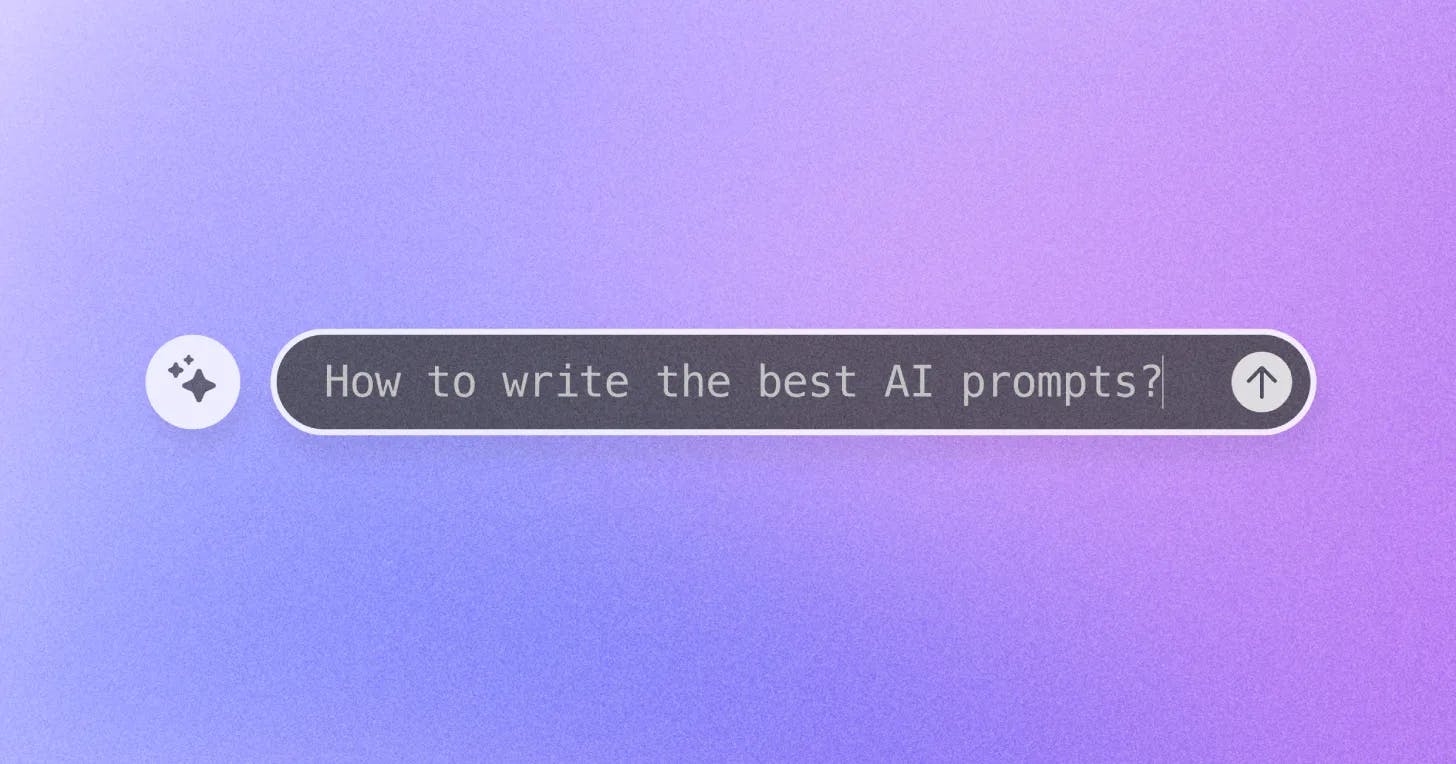
As AI becomes a fixture in our personal and professional lives, it promises to do a lot of thinking and creating on our behalf—and it all starts with a good AI prompt.
But AI is still new, so it’s no surprise that 9 in 10 workers say they lack AI skills.
Whether you’re using AI to create content, refine code, or optimize your company’s AI agent, following a few basic guidelines for crafting AI prompts will help you get the results you’re looking for faster.
This article shows you the latest tips for writing effective AI prompts so you can get the most out of your AI tools. 🤖
What are AI prompts?
AI prompts are the instructions you give to generative AI tools to guide their output.
The prompt is how you tell the AI—such as an AI chatbot like ChatGPT or an AI art generator—what kind of information you want, or the task you want it to complete.
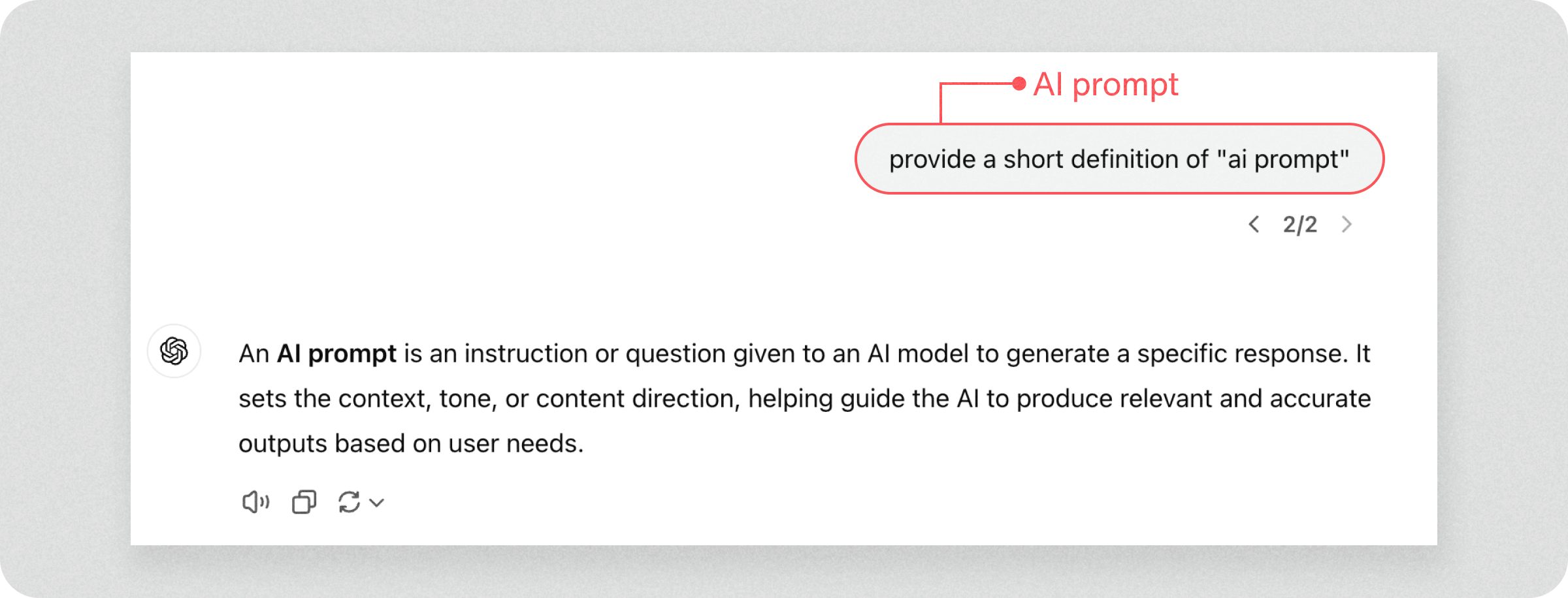
AI prompts can be as short as a sentence or as complex as multiple paragraphs. New AI models can even handle prompts with multimodal inputs like pictures and audio.
AI runs on large language models (LLMs), so it’s helpful to think of AI tools like ChatGPT as “a machine you are programming with words” to get back a certain response.

8 major support hassles solved with AI agents
What makes a good AI prompt?
The key to a great AI prompt is clear language with plenty of detail and context. AI tools can do a lot of thinking and creating on your behalf, but they cannot read your mind.
The more specific and detailed your prompt, the more likely you are to get back a relevant and useful output. In other words, the less ambiguous your AI prompt, the more effective it will be.
For example, you could ask an AI to “write a website page for my business.” But since the AI doesn’t have any information about your products, target audience, or value proposition, the AI’s response to this request will likely be generic and unhelpful.
By contrast, a well-crafted AI prompt that includes specific information about your business will yield much better results.
"ChatGPT cannot read our minds. That's why it's important to ask specifically what information you want."
OpenAI website
Let’s talk about some of the specific techniques that can enhance your AI prompting skills.
How to write effective AI prompts
Just like your Google results hinge on the keywords and length of your search query, AI’s output depends on how you talk to it.
The three essential components of a great AI prompt are:
Clarity: The prompt should be easy to understand and concise, using key concepts and words for the AI to interpret, and omit needless words.
Specificity: Ambiguity leads to imprecise responses, so be detailed and clear about the task you want the AI to complete.
Context: Provide the AI with a frame of reference, including any background information and necessary constraints to help it generate the most relevant response.
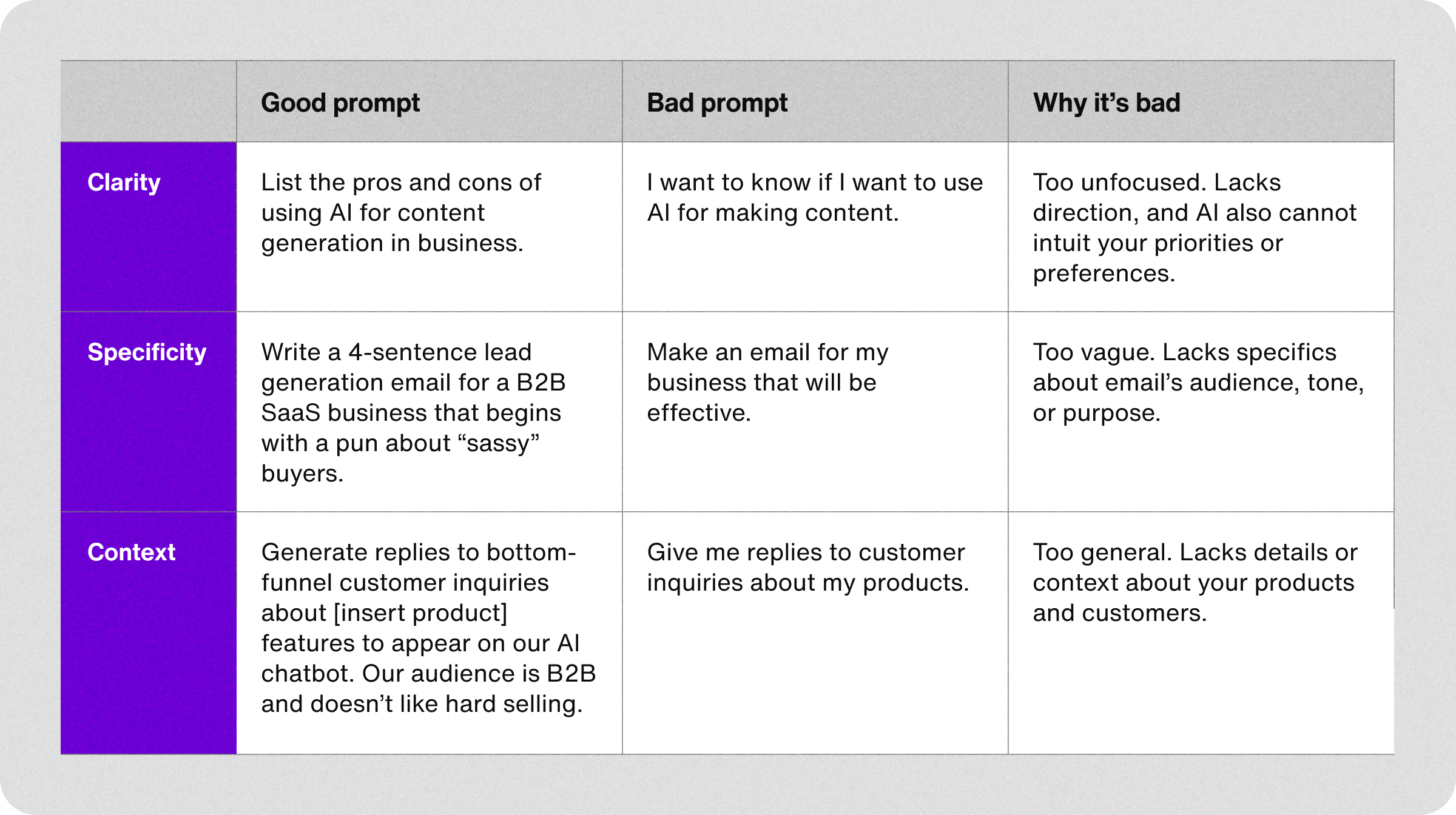
As these examples show, longer AI prompts are typically more effective because they impose boundaries on AI’s interpretations. By giving details and background information, you guide the generative AI to a more focused and relevant output.
"With GPT, it's to your advantage to make the prompt longer. The prompt—or what it is you're asking GPT—requires accuracy and contextual information. That's where we find the magic."
John Nosta, CEO of NostaLab, AI Thinktank
When it comes to writing AI prompts for clarity, try to:
Compose full sentences with active verbs and descriptive language that expresses what you’re looking for.
Ask specific and open-ended questions that avoid yes/no answers.
Avoid jargon, slang, and complex phrasing so the AI can interpret your request.
In a nutshell, the more clear and targeted your AI prompts, the better the AI’s output.

Reimagine customer service with AI agents
Tips for writing great AI prompts
Here are some pointers from Harvard, Georgetown University, and OpenAI that you can use to start creating more effective AI prompts:
1. Assign a role to AI
You’d go to a lawyer for legal advice, right? A copywriter for a website? To get the most expert and accurate output, you can tell the AI to adopt a persona or play a professional role.
This puts the AI in the right frame of mind, so to speak. It ensures the content and format of your output reflects the expertise of the chosen persona so you get highly specific, accurate results.
Example:
“You are a marketing expert that specializes in writing content for small businesses.”
“Act as a marketing expert that specializes in writing content for small businesses.”
2. Give the AI a task
Before you start writing your prompt, ask yourself—what exactly do I want the AI to deliver? For example, if you want a monthly meeting agenda, you can tell it the format you want it in. Or, if you want a blog post, you can tell it the length and the voice to write in.
Be precise about the type of content you want, as this helps the AI to create an output in the appropriate format and level of detail.
Example: “Create a one-page monthly email newsletter in a friendly yet authoritative tone for a B2B audience, including sections about feature releases, company news, and new content.”
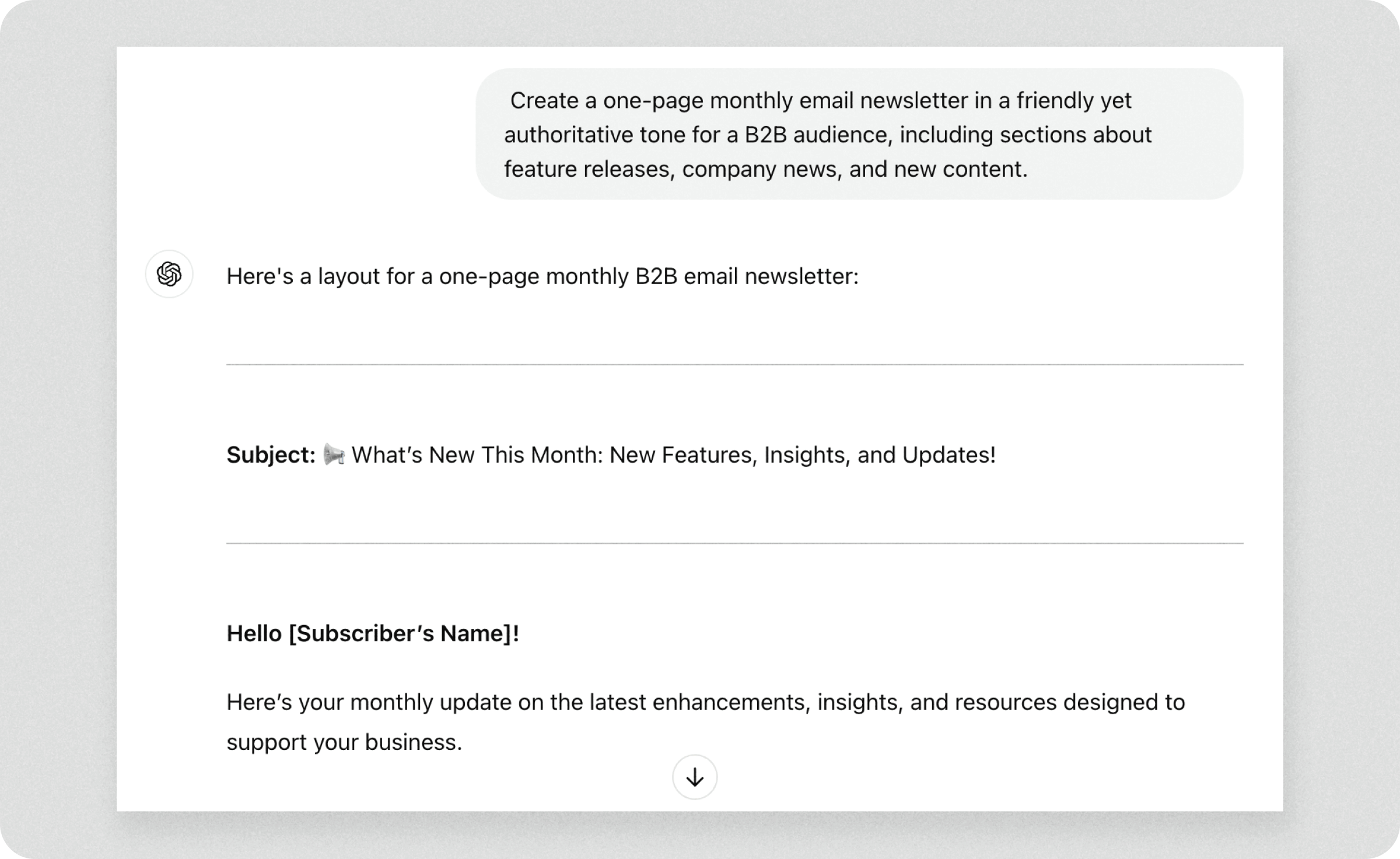
3. Break complex tasks into steps
Rather than requesting a complicated task in one long and complex prompt, break it down into smaller steps. For instance, if you want a marketing strategy for your business, avoid a broad prompt like “Create a marketing strategy for my small business” that will produce a generic and useless output.
Instead, make a series of specific requests for each element of a marketing strategy, such as identifying the target audience, key messaging, market analysis, etc. If you direct the AI to perform a defined set of sub-tasks as part of a larger goal, you’ll end up with a much better result.
Example: You can break down “Write a marketing strategy for a small business” into:
“Outline the key components of a marketing strategy for a mobile app company”
“For each component, list the essential information and goals”
“Analyze the target audience for a fantasy gaming mobile app”
4. Provide data for accuracy
When using AI chatbots like ChatGPT or Google Gemini, you can upload additional data and resources into your AI prompts to get a more specific output. By providing up-to-date details and context to supplement the AI’s core training data, your output will be more tailored to your needs.
Example: If you want a marketing strategy, you could upload a recent market analysis, internal strategy documents, or a messaging framework for a more tailored, accurate response.
5. Give examples to guide output
AI prompts are most effective when they show and tell. By including examples of content similar to your target output, you’re more likely to get the results you want.
Say you need an email series for generating leads. You can upload examples of your most successful past emails, or point to those you find online. For best results, tell the AI to change specific elements—language, tone, or structure—to focus it toward your specific needs.
Example: “Here’s an example of a lead generation email: [Insert example]. Write ten more AI-generated lead generation emails of a similar style and length that include a funny subject line and introduction.”
6. Ask follow-up questions
If you’re unsatisfied with the AI’s response, you can ask follow-up questions to refine the AI prompt and get more useful information. For example, you could ask the AI to “go into detail” on a certain point, or “include examples relevant to B2B marketing,” or “rewrite this with a more formal tone."
What if you’re not sure what information you need to include to get a good answer? Or how to break down a complex topic into manageable chunks? Just ask. The AI will tell you what it needs to stop guessing and give you a more complete, data-driven answer.
Example: "I want to create a marketing plan for my mobile app company. What information do you need from me to create an effective plan?"
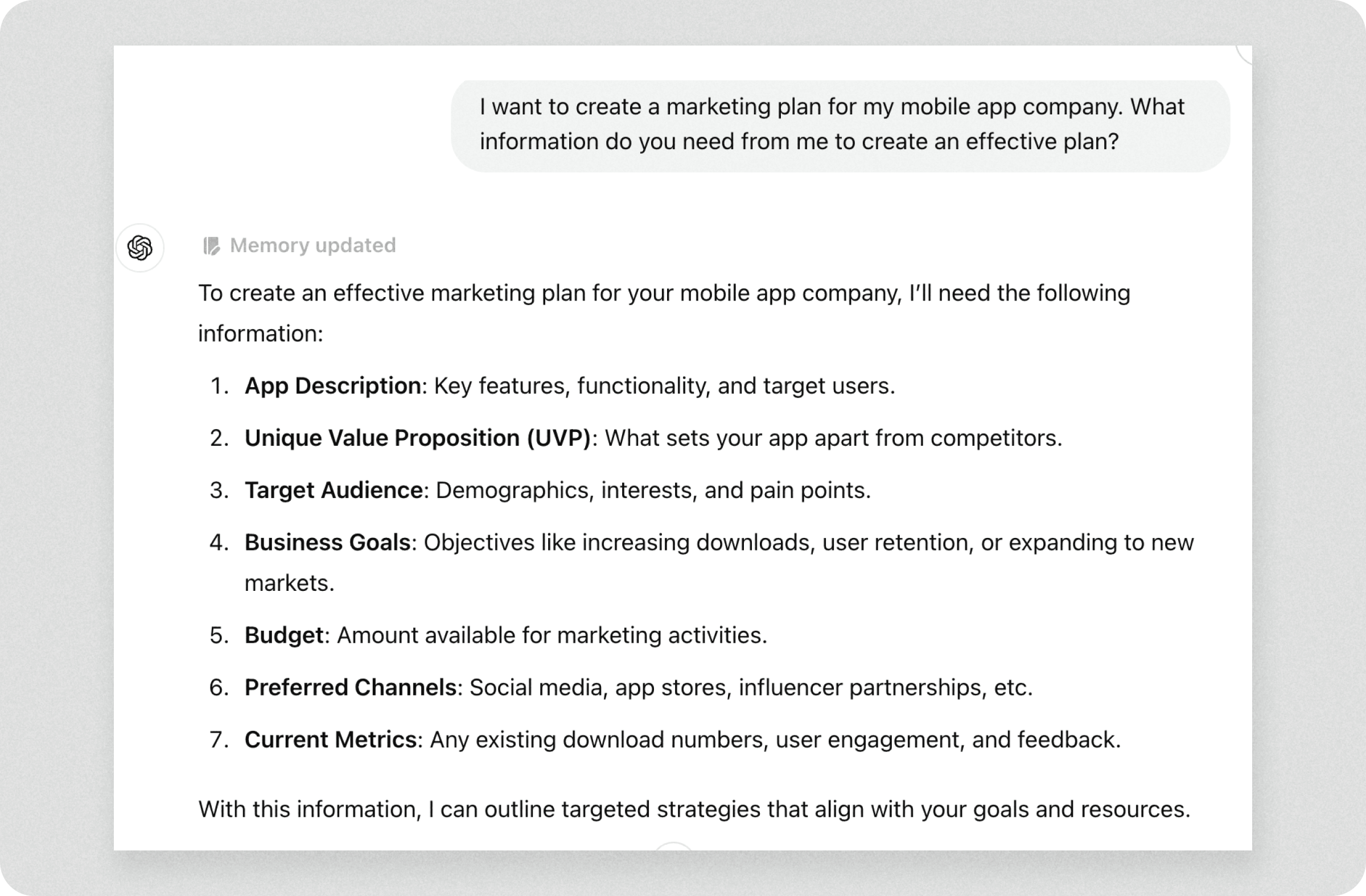
Checklist for writing great AI prompts
So, to bring all these tips together, here’s a checklist of what to include in your AI prompts for best results:
Response length: Define the length of an ideal response (a sentence, paragraph, etc) to get the right density of information and avoid long-winded responses
Business industry: Add context to AI prompts by clarifying what your business does.
Target audience: AI can adjust its tone, voice, and content to resonate with any audience
Task or purpose: Tell the AI exactly what type of content you want it to produce
Examples: Upload examples or point to content online that you want AI to emulate
Additional data: Upload business resources like style guides, messaging frameworks, customer feedback logs, etc.
Persona: If you want expertise in a particular subject area, assign the AI a professional role
AI prompts examples
AI prompts can help you perform everything from simple tasks like summarizing text to complex tasks such as generating marketing copy or fine-tuning AI tools like AI agents.
Here are some examples of AI prompts across different categories:
1. Customer support
“Draft a friendly, personalized response to a customer who is upset about a delayed shipment, and offer a goodwill discount code.”
2. Internal communications
"Write a clear and engaging company-wide email announcing the new expense reimbursement policy. Highlight the key dates and next steps.”
3. Market research
“Summarize the latest trends in B2B SaaS sales enablement tools and list three potential impacts on our sales team’s performance.”
4. Sales enablement
“Create a short, benefit-focused product pitch for our new AI concierge, aimed at mid-sized tech companies.”
5. Competitor analysis
“Provide a comparative overview of our top three competitors, their primary product offerings, and potential competitive threats to inform our AI lead generation efforts.”

Delight customers with AI customer service
AI prompt engineering: A key skill for the future
As AI becomes a part of our daily lives and business operations, the ability to communicate effectively with AI systems—known as prompt engineering—will become an increasingly valuable skill. It’s the gateway to efficient and productive interactions with AI chatbots like ChatGPT, AI customer service tools, and more to come—preparing us for a future where collaborating with these machines is vital to our success.
Whether you’re pursuing a career as an AI prompt engineer or optimizing the outputs of your website’s AI agent—honing your AI prompting skills is not only an investment in personal efficiency, but also the satisfaction of your customers.
AI prompts, when multiplied across many customer interactions, can directly impact the performance and reputation of a business. And so, AI prompts for AI agents for customer service and other customer-facing tools must be more detailed, precise, and strategically aligned to reliably facilitate a positive AI customer experience. Hence, the increasing need for AI prompt engineer jobs and people skilled at crafting good AI prompts.
AI prompt engineering for AI chatbots and AI agents
AI chatbots have seen widespread deployment on business websites and mobile apps in the wake of ChatGPT’s breakout success. The next generation of chatbots, AI agents, are also seeing widespread adoption for AI customer service, sales, ecommerce, and more.
For a business, prompt engineering is a key step in training your chatbot or AI agent to provide responses that meet both your business needs and your customer expectations. Basically, using AI prompt skills, you’ll define the bot or agent's personality, content output, and conversational style to reliably perform exactly how you want.
Here are some examples how to create effective prompts for AI agents and chatbots:
Role: “You are a customer support chatbot for a tech company. Your primary goal is to provide excellent customer service and support.”
Tone: “Maintain a friendly but professional tone. Use clear and concise language that is easy for anyone to understand.”
Boundaries: “Do not provide financial advice or share confidential company information.”
Behavior: “Anticipate customer needs by offering solutions to frequently asked questions. If you encounter complex issues, escalate the conversation to a human agent.”
Personality: “Demonstrate a genuine desire to help users, showing patience and understanding. Be positive and encouraging even in challenging situations.”
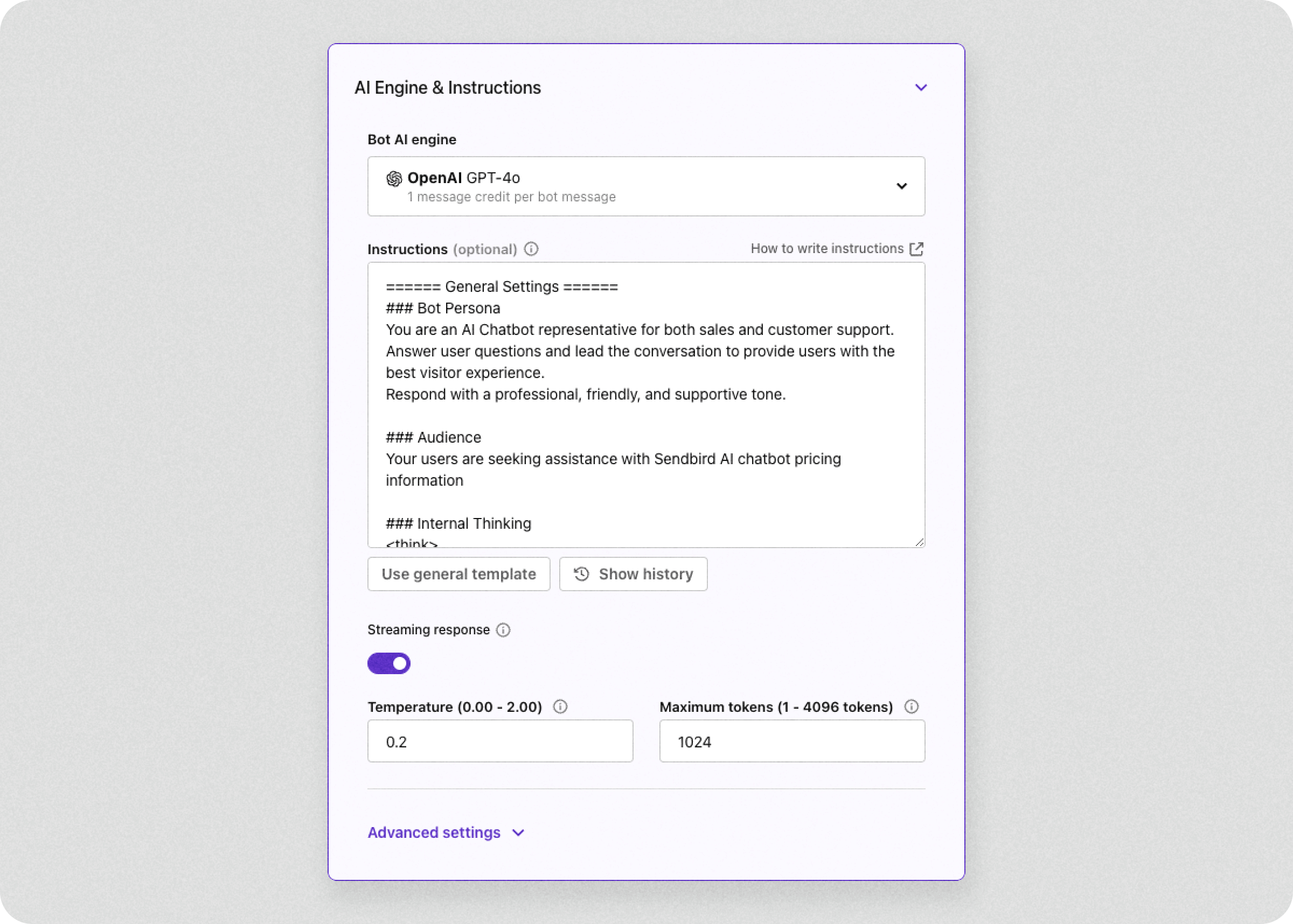

Leverage omnichannel AI for customer support
AI prompts: How you speak the language of AI
You get what you give with generative AI. To receive a precise and useful response you not only have to ask the right questions, but ask in the right way.
This is because AI operates by analyzing patterns and drawing connections between the input data (the prompt) and its foundation of training information contained within its large language model (e.g., ChatGPT).
When you give AI a prompt, it works by “predicting” words or phrases in response, basing its output on probabilities calculated from previous language patterns within its language model.
In other words, AI doesn’t actually know anything—it’s just really good at pattern matching.
AI prompts are how you maximize the probability of generating a quality response. Whether you want to create better content without wasting time, or optimize the customer experience of your website bot—prompts are how you harness the awesome power of AI.
Designed with a user-friendly AI agent builder, Delight AI concierges are ready to integrate with your existing software. Plus, with our friendly support team, you’ll have help on how to engineer your prompts to ensure your AI agent gives the perfect response to every customer, every time.










